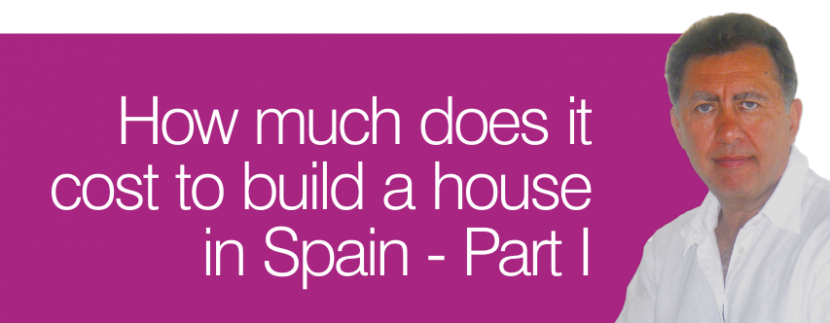How much does it cost to build a house in Spain - Part I

I have been asked this question pretty often and apart from answering (discourteously, I must say) with another question such as how long is a piece of string? This week we will try to provide a reasonable accurate answer to this question by analysing the cost of construction of a typical house.
The reason I decided to write this month’s article on this subject is because it has come to my attention the report published by the world wide consultancy EC Harris.
According to them, to construct a building from design stage to the finished building, including site acquisition, materials and labour, is in Spain 40% cheaper than in most EC countries, as recently released by the property consultancy EC Harris.
The study, conducted on a total of 29 countries and on five continents, shows that the price of construction in Spain is 18% cheaper than in France, 29% cheaper than in Holland and Italy and up to 71% below the average price of Ireland, surprise surprice…
For these experts, these data support the fact that higher housing prices are due to rising land prices and not to the increase of the remaining construction costs.
This report also reveals that only the countries of Eastern Europe presents construction costs lower than in Spain which.
For the rest of the world, Indonesia, Philippines and the United Arab Emirates are the countries with the lowest construction costs. In the other extreme we find Japan, Australia and the United States and particularly Denmark, where to build a house is more than twice as expensive as in Spain.
Economic growth in Western Europe has been slow and the Eurozone is expected to grow by 1.9% this year with a further 1.7% in 2012. The slow recovery from recession has hit the construction sector and construction price movements have generally been restrained. Construction prices in France, Germany and Italy have remained virtually unchanged over the past year and remain 13%, 7% and 1% respectively above the level of pricing in the UK.
In Eastern Europe, there are more signs of recovery with growth in the new EU member countries expected to be 3.0% this year followed by a further 3.6% increase in 2012 while the economies of both Poland and Russia are expected to grow by 4 and 4.5% this year and next. Construction price in Russia rose by 9% over the past year, according to the EC Harris figures, while prices in Poland are approx 30% cheaper than the UK and fell by around 5% over the year. The fall in prices in Poland comes despite the ongoing preparation for the Euro 2012 Football Championship and substantial investment of EU structural funds in major infrastructure works.
Once we have seen how world construction market prices are fluctuating around the world perhaps we can take a look at a break down in costs related to building a house in Spain.
Normally there are a number of factors that govern local prices and these factors are:
1) Type of construction. Is it an individual house, an apartment?
2) General Market situation. Is it a buoyant, market in recession? etc. (Any doubts?)
3) Access to site. Is it complicated, difficult, easy?
4) Site topography. Is it on an abrupt slope, on a horizontal plane?
5) Exact location of the site. There are price variations even within an Autonomous Community or even a province.
House shape. If we take a single storey house with a floor area of 100m2 and the floor plan is 10m by 10m, the total length of façade is 40m. The same area of 100m2 on a building with a façade of 5m by 20m, the area still 100m2 but the length of façades is 50m, we have 10m more of façade for the same building area.
6) Total amount of garden left over after building our house. Normally we have to fence it off, do same planting or hard landscaping etc.
7) Number and size of bathrooms. The bathrooms together with the kitchens are normally the most expensive rooms in the house.
8) Finishes. Obviously the quality of the finishes will have an impact on the final cost of the house.
9) The selection of the type of foundations, if concrete pads, deep trench, etc.
10) What type of soil we will have to do the excavation? It isn’t the same to excavate on rock than to excavate on soft sand.
11) Type of structure. Is it reinforced concrete frame, load bearing walls, timber frame? Etc.
12) Installation services. We will have air conditioning, central heating, solar thermal panels?
13) Type of façade construction. Is it a cavity brick wall with thermal insulation, do our windows have double glazing?
14) Type of external walls. Are our external windows and doors made of aluminium or are they timber joinery?
15) Type of roof. Are our roofs double pitched, with tiles or is it a flat roof with access to a solarium?
16) Finishes. Are our floors and walls covered with tiles or we have an expensive marble?
With these elements decided on, we are able to provide an estimate of the total cost of construction and this cost should be pretty accurately within the standard local market price and that is what we will show on next month’s article.

 Spanish
Spanish German
German Dutch
Dutch